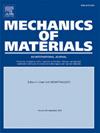Efficient prediction of strength and strain localisation in porous solids via microstructure-based limit analysis
IF 3.4
3区 材料科学
Q2 MATERIALS SCIENCE, MULTIDISCIPLINARY
引用次数: 0
Abstract
A new method is presented to predict strength and strain localisation in solids containing voids or soft particles at reduced computational cost compared to traditional micro-mechanical approaches. The method leverages the fact that strain localisation in such materials occurs in the form of narrow shear bands connecting the voids. Accordingly, the model domain is discretised with rigid triangular blocks defined by the Delaunay triangulation of the void centroids. Deformation and energy dissipation are assumed to be confined to discontinuities of the velocity field introduced along the block edges, representing the narrow zones of strain localisation within the shear bands. The block velocities are computed within the framework of plastic limit analysis by minimising the total rate of internal work while ensuring compatible deformation across the solid. Accordingly, the predicted strength represents an upper bound. The adopted microstructure-based discretisation strategy effectively limits the number of potential discontinuities compared to similar methods proposed in the literature, thereby increasing the computational efficiency. To demonstrate the capabilities of the method, predicted macroscopic strength under uniaxial tension and strain localisation patterns in 2D porous microstructures with varying porosity fractions are compared to the finite element results.
通过基于微观结构的极限分析有效预测多孔固体的强度和应变局部化
与传统的微力学方法相比,提出了一种新的方法来预测含有孔隙或软颗粒的固体中的强度和应变局部化,并且减少了计算成本。该方法利用了这样一个事实,即这种材料中的应变局部化以连接空隙的窄剪切带的形式发生。据此,用孔洞质心的Delaunay三角剖分定义的刚性三角块对模型域进行离散。假设变形和能量耗散仅限于沿块体边缘引入的速度场的不连续,代表剪切带内应变局部化的狭窄区域。块速度是在塑性极限分析的框架内通过最小化内部工作的总速率来计算的,同时确保整个固体的兼容变形。因此,预测强度代表一个上限。与文献中提出的类似方法相比,所采用的基于微观结构的离散化策略有效地限制了潜在不连续的数量,从而提高了计算效率。为了证明该方法的能力,将具有不同孔隙率的二维多孔微结构在单轴拉伸和应变局部化模式下的预测宏观强度与有限元结果进行了比较。
本文章由计算机程序翻译,如有差异,请以英文原文为准。
求助全文
约1分钟内获得全文
求助全文
来源期刊

Mechanics of Materials
工程技术-材料科学:综合
CiteScore
7.60
自引率
5.10%
发文量
243
审稿时长
46 days
期刊介绍:
Mechanics of Materials is a forum for original scientific research on the flow, fracture, and general constitutive behavior of geophysical, geotechnical and technological materials, with balanced coverage of advanced technological and natural materials, with balanced coverage of theoretical, experimental, and field investigations. Of special concern are macroscopic predictions based on microscopic models, identification of microscopic structures from limited overall macroscopic data, experimental and field results that lead to fundamental understanding of the behavior of materials, and coordinated experimental and analytical investigations that culminate in theories with predictive quality.
 求助内容:
求助内容: 应助结果提醒方式:
应助结果提醒方式:


